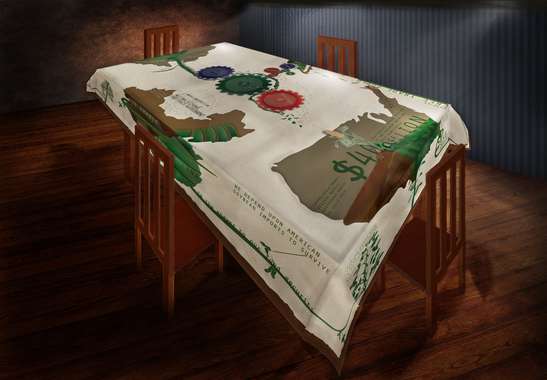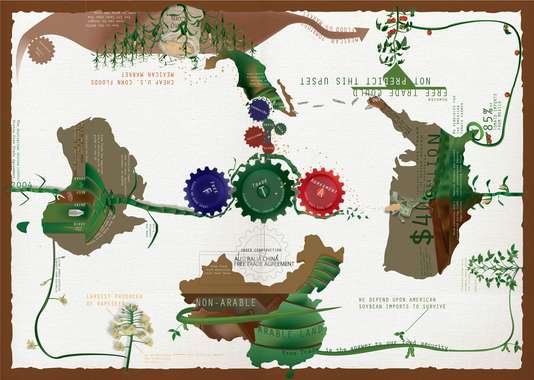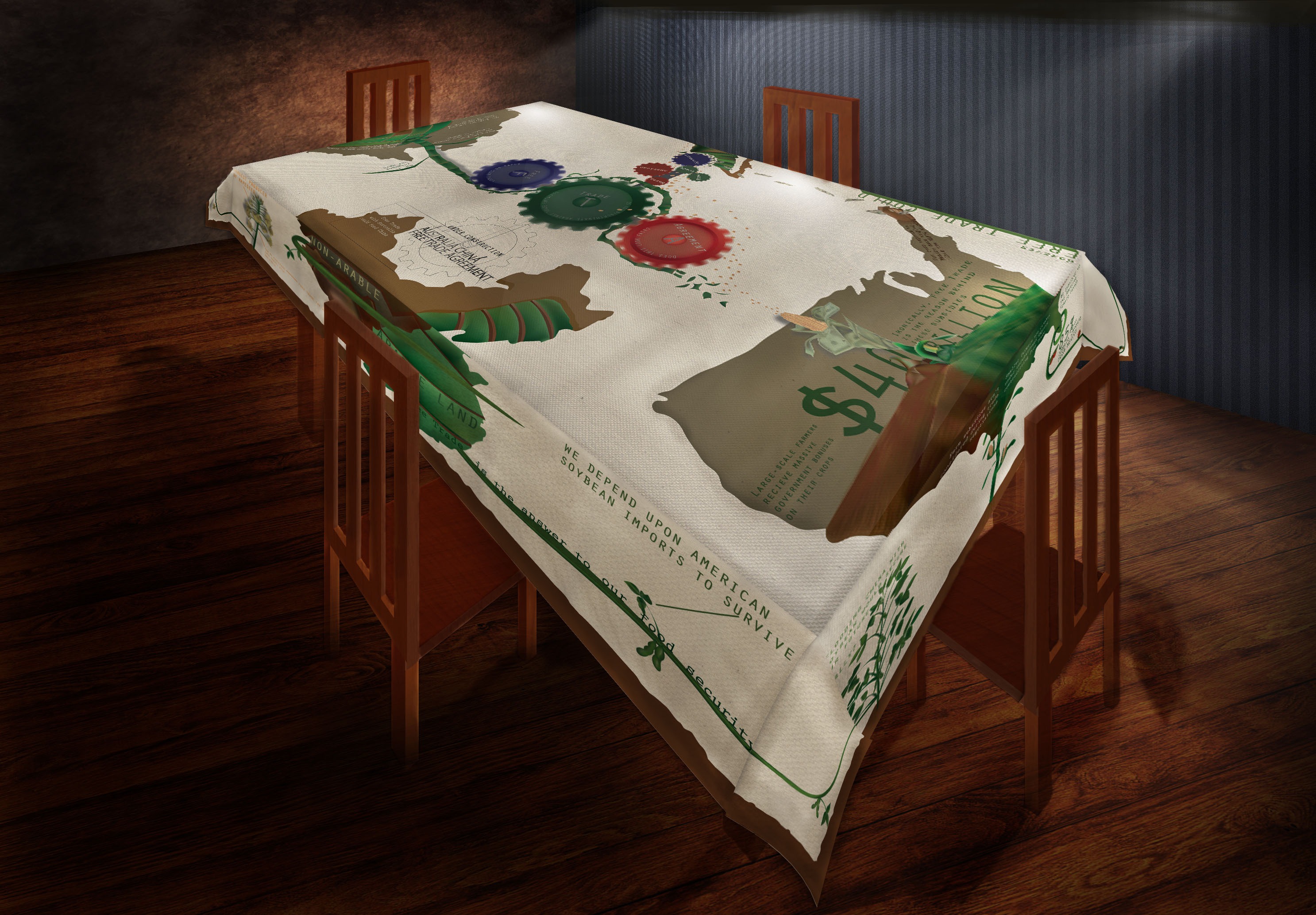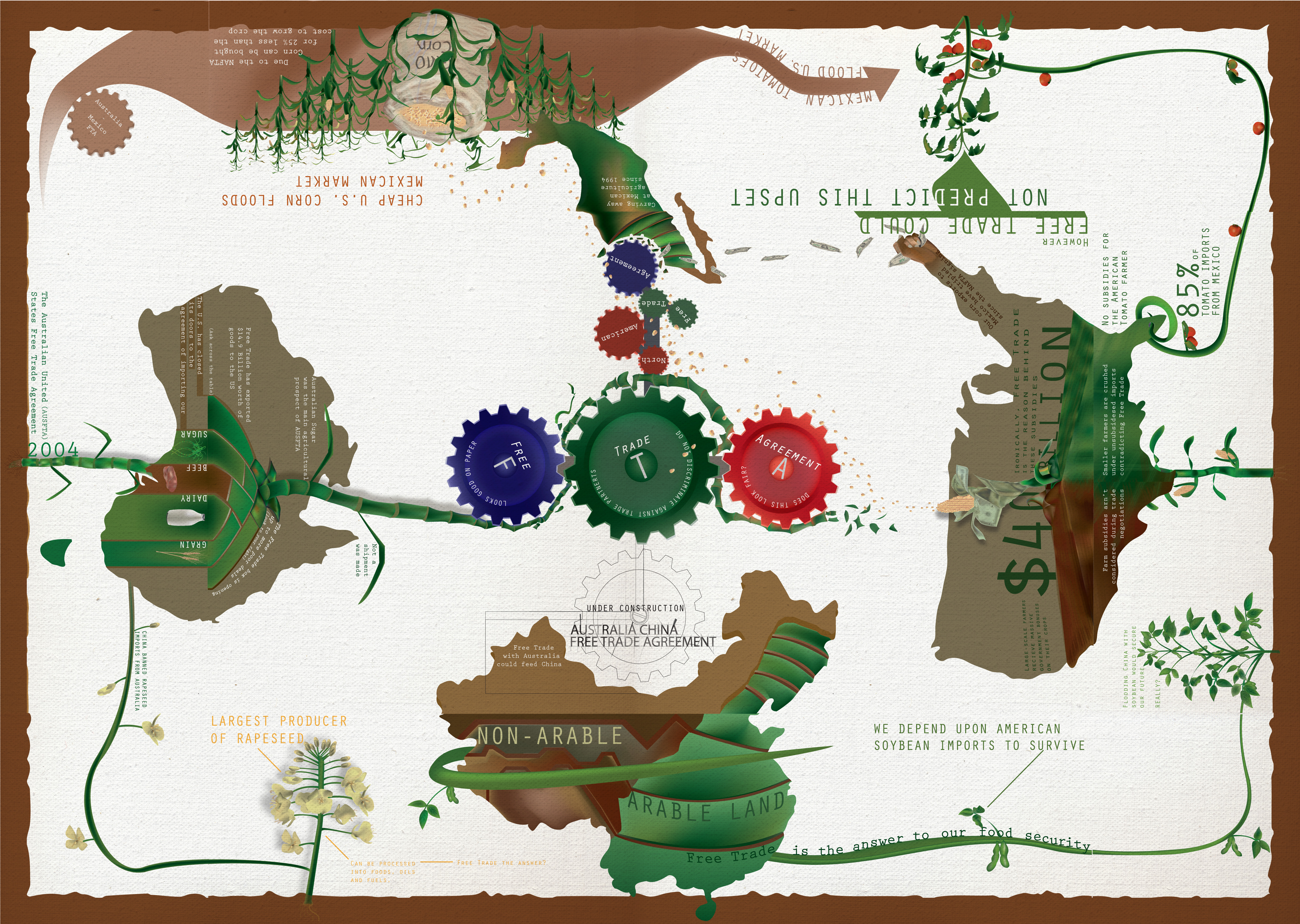The FTA (FOOD TRADE APPARATUS)
by Tomotron
This work has been commented by 2 curator(s). Read the comments
Title
The FTA (FOOD TRADE APPARATUS)
Headline
How Free Trade impacts Food
Concept author(s)
Thomas Roohan
Concept author year(s) of birth
1989
Concept author(s) contribution
Concept development, design process and presentation.
Concept author(s) Country
Australia
Friendly Competition
Competition category
Visual communication practice
Competition subcategory
static
Competition field
academic
Competition subfield
student
Subfield description
Griffith University Queensland College of Art
Check out the Food Democracy 2013 outlines of Memefest Friendly competition.
Description of idea
Describe your idea and concept of your work in relation to the festival outlines:
The prospect of food reaching our dinner plates is expected when we go to the supermarket, local deli and farmers markets. It’s as simple as choosing what you want and exchanging your money over for the food. In a way you are trading in what may or may not be a fair deal, but one thing for certain is that it isn’t a ‘Free Trade’. Free Trade, it is a familiar phrase based on the people I asked, but familiarity is where it ends. In summary, Free Trade is a way for governments and multi-national businesses to conduct their international trading of resources. Partnered countries remove the import tax that is usually in place for the exports of their partner country. In theory the system entitles exporting countries more freedom in what they can export and cheaper imports for consumers. The ideal outcome of equal party benefit is rarely achieved. It means more of one food such as corn can be exported at little to no cost to the partner country without regarding the aftermath of what follows. A system that is based primarily around supply and demand of food creates power imbalances for the people who just want to survive self sufficiently.
What kind of communication approach do you use?
Thinking about how food gets to the dinner plate is an important place for discussion in terms of food democracy. The issue of Free Trade might be thought of as a little dry for dinner table conversation, but the reality is that it doesn’t have to be. This approach resulted in an informational illustration imbedded into a dining table cloth. The cloth sizing is based around 2500 mm x 1750mm printed onto linen. It has been designed to scale down evenly. The graphics envelope contours of the table in a way that the information and images swirl and wrap around the 4 corners of the table. As for the content itself, each of the four sides of the table are represented by a country. Australia, USA, Mexico and China. The countries each have their own relationship to agriculture, but also an interrelation between their respective Free Trade Agreements. The interconnections show how their particular FTAs are carried out. The binding elements are the 3 cogs in the centre of the design. These represent the commodification of food as it passes through these agreements. Food is grown from the soil at the outer edges of the design and as it passes through it becomes nothing more than a product of profit.
What are in your opinion concrete benefits to the society because of your communication?
On a small scale I would like to think that communication methods such as this would encourage people to have more kitchen/dining table discussions related to what they’re doing at that moment. The piece encourages people to question the politics behind the future of their food. Our politicians are always travelling abroad to negotiate free trade deals and it is often proclaimed that they’re travelling for no particular reason. What I also wanted to balance is the desire to understand our own situation within Australia and how it is impacted by the relationship with USA or China. E.g. Why should people care what is happening on the other side of the world? Is an important question to ask in order to gain local support.
What did you personally learn from creating your submitted work?
There are many things to consider on the subject of free trade. Food Democracy isn’t limited to the local environments, but also the international because it will always filter down into our local communities. Thinking of free trade at a domestic level is important because it has in some way impacted our interaction at the supermarket, corner store and the farmers market. I also learnt that a lot of people simply have no idea what Free Trade is, but with new future negotiations taking place this will change anyway.
Why is your work, GOOD communication WORK?
The work sets the scene for conversation between people who may currently have or no opinion on the issue. Instead of an infographic as it is usually seen, one directional communication. This method allows multiple people to engage on the same medium, yet each have a different perspective on the subject even if they weren't previously aware of Free Trade. It creates valuable dialogue between those who are sitting at the table.
Where and how do you intent do implement your work?
The project could be implemented in numerous environments. Small scale restaurant or café businesses could find this project of interest. I began to have thoughts about more applications of the concept in terms of content. My main focus at the moment is Free Trade, but utilising a table cloth as a medium for dining table discussions could open up more opportunities for public participation. Towards the end of my development I started to think about how people could contribute to the stories that are already in the cloth. The illustrative nature of the design might encourage people to add their own branches of food interests. I’ve left areas of white space on the fabric for people to write down and draw in their food stories.
Did your intervention had an effect on other Media. If yes, describe the effect? (Has other media reported on it- how? Were you able to change other media with your work- how?)
n/a
Curators Comments
Roderick Grant
The appropriation of the dining table is a successful intervention. As a gesture, the work occupies the space of an activity - the eating of a meal - which lends it a somewhat captive audience for its message. I'm immediately struck by the opportunity to continue the occupation of 'eating space' to include all items in the performance - napkins, plates, cutlery, glasses, etc.
The complexity and inter-relationships in the information graphic could then extend beyond the flat, into the performative space of the meal itself. Countries could thus potentially not just relate to one another on the surface of a table, but through the acts and motions of eating while seated at the table.
What matters here though, is that the work clearly identifies the potential to go forward into this realm of performance - a more fleshed out system of this kind could occupy a café, a small restaurant, or become a performance-piece/installation in a gallery.
In the expansion of the system, the consideration of the relationships between information could be enhanced to include not just the food, but the objects themselves - where the forks were made, etc. This kind of expansion into the physical also relieves some of the pressure on the information graphic to communicate all aspects of the message at once - as objects might carry a message themselves, they can carry and simplify parts of a more complex communication experience.

Scott Townsend
I think this is a rather elegant idea conceptually.
One of the things I was wondering about this year with the food democracy theme was whether submissions would evidence the ideas of performance and the actual body. Food as subject brings up some very ingrained behaviors, such as rituals, daily cycles, basic fundamental social relationships, and therefore how whatever information or story is told should consider those particular contexts. The tablecloth is a simple idea but the potential to think through contextual behaviors in the daily cycle of 'family meal' etc. are the start of something much more engaging and interesting.
So my point here is that the author is just starting to think about behaviors and experiences in a time-sense and how to engage people with the simple idea of 'tablecloth' and the context of a ritual. What would be a mistake is to see this as a one-off simple ironic juxtaposition (tablecloth as infographic). There are methods and practices that can help extend this idea and I hope that this is a start to a broader investigation through a broader idea of systems.




